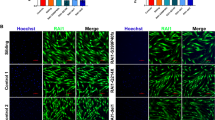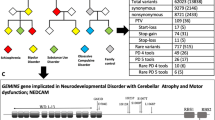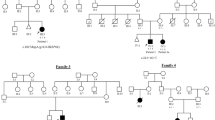Abstract
Smith–Magenis syndrome (SMS) is a complex disorder whose clinical features include mild to severe intellectual disability with speech delay, growth failure, brachycephaly, flat midface, short broad hands, and behavioral problems. SMS is typically caused by a large deletion on 17p11.2 that encompasses multiple genes including the retinoic acid induced 1, RAI1, gene or a mutation in the RAI1 gene. Here we have evaluated 30 patients with suspected SMS and identified SMS-associated classical 17p11.2 deletions in six patients, an atypical deletion of ∼139 kb that partially deletes the RAI1 gene in one patient, and RAI1 gene nonsynonymous alterations of unknown significance in two unrelated patients. The RAI1 mutant proteins showed no significant alterations in molecular weight, subcellular localization and transcriptional activity. Clinical features of patients with or without 17p11.2 deletions and mutations involving the RAI1 gene were compared to identify phenotypes that may be useful in diagnosing patients with SMS.
Similar content being viewed by others
Log in or create a free account to read this content
Gain free access to this article, as well as selected content from this journal and more on nature.com
or
References
Greenberg F, Guzzetta V, Montes de Oca-Luna R et al: Molecular analysis of the Smith-Magenis syndrome: a possible contiguous-gene syndrome associated with del(17)(p11.2). Am J Hum Genet 1991; 49: 1207–1218.
Smith ACM, Magenis RE, Elsea SH : Overview of Smith-Magenis syndrome. J Assoc Genet Technol 2005; 31: 163–167.
Elsea SH, Girirajan S : Smith-Magenis syndrome. Eur J Hum Genet 2008; 16: 412–421.
Smith ACM, Boyd K, Elsea SH et al: Smith-Magenis Syndrome; in: GeneReviews at GeneTests: Medical Genetics Information Resource (database online). Seattle: Copyright, University of Washington, 1997–2010.
Dykens EM, Finucane BM, Gayley C : Brief report: cognitive and behavioral profiles in persons with Smith-Magenis syndrome. J Autism Dev Disord 1997; 27: 203–211.
De Leersnyder H, de Blois MC, Vekemans M et al: beta(1)-adrenergic antagonists improve sleep and behavioural disturbances in a circadian disorder, Smith-Magenis syndrome. J Med Genet 2001; 38: 586–590.
Smith AC, Dykens E, Greenberg F : Sleep disturbance in Smith-Magenis syndrome (del 17 p11.2). Am J Med Genet 1998; 81: 186–191.
Potocki L, Shaw CJ, Stankiewicz P et al: Variability in clinical phenotype despite common chromosomal deletion in Smith-Magenis syndrome [del(17)(p11.2p11.2)]. Genet Med 2003; 5: 430–434.
Vlangos CN, Yim DK, Elsea SH : Refinement of the Smith-Magenis syndrome critical region to approximately 950 kb and assessment of 17p11.2 deletions. Are all deletions created equally? Mol Genet Metab 2003; 79: 134–141.
Slager RE, Newton TL, Vlangos CN et al: Mutations in RAI1 associated with Smith-Magenis syndrome. Nat Genet 2003; 33: 466–468.
Bi W, Saifi GM, Shaw CJ et al: Mutations of RAI1, a PHD-containing protein, in nondeletion patients with Smith-Magenis syndrome. Hum Genet 2004; 115: 515–524.
Bi W, Saifi GM, Girirajan S et al: RAI1 point mutations, CAG repeat variation, and SNP analysis in non-deletion Smith-Magenis syndrome. Am J Med Genet A 2006; 140: 2454–2463.
Girirajan S, Elsas LJ, Devriendt K et al: RAI1 variations in Smith-Magenis syndrome patients without 17p11.2 deletions. J Med Genet 2005; 42: 820–828.
Truong HT, Dudding T, Blanchard CL et al: Frameshift mutation hotspot identified in Smith-Magenis syndrome: case report and review of literature. BMC Med Genet 2010; 11: 142.
Carmona-Mora P, Encina CA, Canales CP et al: Functional and cellular characterization of human Retinoic acid induced 1 (RAI1) mutations associated with Smith-Magenis Syndrome. BMC Mol Biol 2010; 11: 63.
Carmona-Mora P, Walz K : Retinoic acid induced 1, RAI1: a dosage sensitive gene related to neurobehavioral alterations including autistic behavior. Curr Genomics 2010; 11: 607.
Girirajan S, Truong HT, Blanchard CL, Elsea SH : A functional network module for Smith-Magenis syndrome. Clin Genet 2009; 75: 364–374.
Griggs BL, Ladd S, Decker A et al: Identification of ectodysplasin-A receptor gene deletion at 2q12.2 and a potential autosomal MR locus. Eur J Hum Genet 2009; 17: 30–36.
Edelman EA, Girirajan S, Finucane B et al: Gender, genotype, and phenotype differences in Smith-Magenis syndrome: a meta-analysis of 105 cases. Clin Genet 2007; 71: 540–550.
Williams SR, Girirajan S, Tegay D et al: Array comparative genomic hybridisation of 52 subjects with a Smith-Magenis-like phenotype: identification of dosage sensitive loci also associated with schizophrenia, autism, and developmental delay. J Med Genet 2010; 47: 223–229.
Toulouse A, Rochefort D, Roussel J et al: Molecular cloning and characterization of human RAI1, a gene associated with schizophrenia. Genomics 2003; 82: 162–171.
Vieira G, Rodriguez JD, Boy R et al: Differential diagnosis of Smith-Magenis syndrome: 1p36 deletion syndrome. Am J Med Genet A 2011; 155: 988–992.
Acknowledgements
We are grateful to the patients and the parents for participation in this study. We thank Cindy Skinner, Lynn Dukes-Rimsky, Raewyn Lowe, Melissa Cook, Julianne Collins and Carlos Eduardo Frigério Domingues for providing assistance at various stages of this study. We thank Sarah H Elsea for sharing RAI1 gene primer sequences. This study was supported in part by funds from the SC Department of Disabilities and Special Needs, a fund from the Coordination for the Improvement of Higher Education Personnel (CAPES) foundation, Brazil to GHV, and a fund from the Jerome Lejeune Foundation to KW.
Author information
Authors and Affiliations
Corresponding authors
Ethics declarations
Competing interests
The authors declare no conflict of interest.
Additional information
Supplementary Information accompanies the paper on European Journal of Human Genetics website
Supplementary information
Rights and permissions
About this article
Cite this article
Vieira, G., Rodriguez, J., Carmona-Mora, P. et al. Detection of classical 17p11.2 deletions, an atypical deletion and RAI1 alterations in patients with features suggestive of Smith–Magenis syndrome. Eur J Hum Genet 20, 148–154 (2012). https://doi.org/10.1038/ejhg.2011.167
Received:
Revised:
Accepted:
Published:
Issue date:
DOI: https://doi.org/10.1038/ejhg.2011.167



